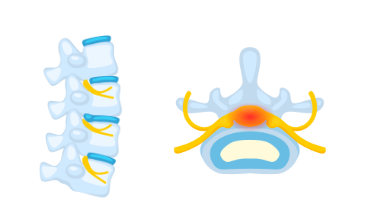The spine
The spine is made up of 33 separate bones, known as vertebrae, extending from the base of the skull to the coccyx (tailbone). Each vertebra surrounds and protects the spinal cord (nerve tissue).
The spinal cord carries out two main functions, and is effectively a superhighway for communication of signals.
Firstly, it connects a large part of the nervous system to the brain. Nerve impulses are transmitted to the spinal cord through sensory neurons. These impulses are then transmitted by the spinal cord to the brain. This pathway is known as the ascending tract of nerves. In the reverse process, impulses are generated in the brain, which are transmitted down the cord and leave by the motor neurons. This pathway is known as the descending tract of nerves.
Secondly, the spinal cord acts as a co-ordinating centre in order to produce simple reflexes such as the withdrawal reflex.
The area within the spinal column beyond the end of the spinal cord is called the cauda equina. The nerves that branch out from the spinal cord to the other parts of the body are called lower motor neurons (LMNs) and dorsal root sensory neurons.

